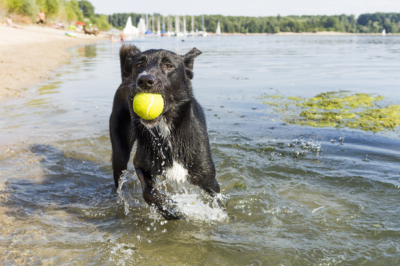
It’s HOT out! Heat waves seem like the best time to take the pooch to a pond, lake, river, or stream, where she can get some exercise while staying cool and hydrated. Ironically, it may be the worst time to do this. From mid-summer to early fall, cyanobacteria, the dangerous bacteria often referred to as blue-green algae, ‘blooms’ in full force, turning nature’s water parks into poisonous hotspots for pets and their humans.
Many cyanobacteria species produce toxins, including:
- Hepatotoxins that affect the liver and can result in liver failure within hours of exposure.
- Dermatoxins that affect the skin and cause itching and blistering. These symptoms are not fatal but are uncomfortable and can take up to several weeks to resolve.
- Neurotoxins that affect the central nervous system and cause muscle tremors, paralysis, and cyanosis (lack of oxygen to tissues) within minutes to hours of exposure. Paralysis of the diaphragm results in respiratory failure and death.
These toxins enter the body so quickly that the animal is usually sick before reaching medical care, often too late to remove them.
Not all bodies of water contain cyanobacteria and not all species produce dangerous toxins. However, it’s extremely difficult to identify safe from dangerous. When in doubt, err on the side of caution and keep your pet away from the water.
That said, your pup can still have splish-splash fun in the sun. There are plenty of safe ways for your dog to get wet ‘n wild this summer!
How to create your own waggin’ water park:
- Get a wading pool large enough for your dog to splash around or lay down in. Some varieties even have built-in sprinklers! Some dogs may be more comfortable in a pool with a non-slip surface.
- Set up a “bobbing for toys” game in the same pool or in a bucket or bin you can fill with water.
- Play fetch with the sprinklers on. If your dog is uncomfortable with spraying water, try playing with a toy that can be soaked in water.
- If your dog loves agility training, there are jump-through hoops that sprinkle water and dog-safe water slides you can add to the mix. You can also simply add sprinklers to your existing setup.
If you don’t have your own outdoor space:
- Visit a dog park that has a splash pad and fresh drinking water. Some regular parks feature splash pads in the summer, too, but be sure to check the pet policy before going.
- If there aren’t any pet-friendly splash pads around or if your dog gets overwhelmed in busy places, look for spaces with running tap water, such as a baseball diamond or sports field, and bring your water toys with you.
Safety always comes first.
Sometimes, it’s best to stay inside. When it’s too hot outside for you, it’s too hot for your dog. Be conscientious if your dog is a puppy or senior, is a brachycephalic (flat-faced) breed, or has a medical condition that can make high temperatures less tolerable (e.g., obesity, heart disease, conditions affecting the respiratory system).
Standing water in the backyard is at risk for contamination, too. Water left in pools, buckets, and drinking bowls should be replaced every day.
Supervise your pet as diligently as you would a two-year-old child. Water accidents happen and hot weather can still affect even the healthiest of dogs.
Keep your cat safe, too.
Cats with outdoor access often leave the home base and could be at risk of toxic exposure. If you live within a few miles or kilometers of at-risk waters, keep your cat inside. For some cats, long-term confinement can be distressing and detrimental to their emotional wellbeing. If this is the case with your cat, here are some things that might minimize his excursions away from home:
- Provide essential kitty resources, including fresh running water (i.e., water fountain), napping spots in the shade (e.g., cat hammock or bed), designated places to do his “business” (e.g., soil bed, litter box), and vantage points (e.g., elevated doghouse with escape door, safe way to climb to a balcony) to escape threats, such as unfamiliar visitors (human or animal).
- Play with your cat daily, ideally with toys that mimic prey to provide an outlet for his natural hunting behaviors (stalk, chase, pounce).
- Spay/neuter your cat to prevent the search for new territory or mates.
- Enrich your cat’s indoor environment so he believes that inside is even better than outside!